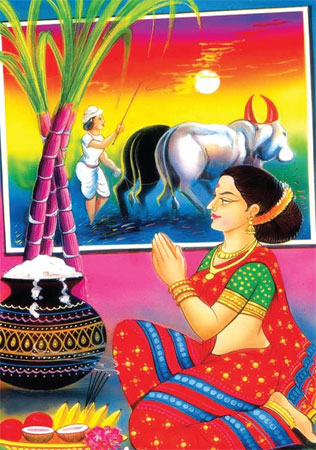Significance of the Thai Pongal rituals
People celebrating Pongal should be aware of the meaning and
significance of the rituals associated with this harvest festival.
Pongal or Thai Pongal is also called Makara Sankaranthi, since it is
celebrated on the first day of Thai when the Sun enters the Makara Rasi
(Capricorn).
This signals the end of winter and the onset of spring throughout the
northern hemisphere. For the next six months, the days are longer and
warmer. The period is referred to as Uttarayan Punyakalam and is
considered auspicious.

Legend has it that the Devas wake up after a six-month long slumber
during this period. And so it is believed that those who pass away
during Uttarayana attain salvation. In fact, Bheeshma is believed to
have waited for the dawn of Uttarayana before he gave up his life.
Pongal is a four-day affair. The first day, Bhogi, is celebrated on
the last day of the month of Margazhi. On this day, people decorate
their homes. New vessels are bought and old and unwanted things burnt.
Scholars have often compared Bhogi to the Indra Vizha celebrated by
the Chola kings at Kaveripattinam, also known as Poompuhar. Indra Vizha
was celebrated in honour of Lord Indra, also called Bhogi, the God of
thunder and rain.
The second day is Perum Pongal, which is the most important. It is
also called Surya Pongal because people worship Surya, the Sun God and
his consorts, Chaya and Samgnya. Women decorate the central courtyard of
their homes with beautiful kolams, done with rice flour and bordered
with red clay. The Pongal dish is cooked exactly at the moment when the
new month is born.
There are several legends associated with Perum Pongal. A sage named
Hema prayed to Lord Vishnu on the banks of the Pottramarai tank in
Kumbakonam. On Perum Pongal day, the Lord is believed to have taken the
form of Sarangapani and blessed the sage. Yet another legend has it that
Lord Siva performed a miracle where a stone image of an elephant ate a
piece of sugarcane. The third day is Mattu Pongal, celebrated to glorify
cattle that help farmers in a myriad ways. On this day, the cows are
bathed and decorated with vermilion and garlands and fed. In certain
villages in southern Tamil Nadu, a bullfight called manji-virattu is
held in the evening. Bags of coins are tied to the sharpened horns of
ferocious bulls that are let loose in an open ground. The young men of
the village vie with each other to subdue the bull and grab the bags
tied to the horns.
In fact, in ancient Tamil literature, men had to subdue the bull to
win the hand of a fair maiden and even Lord Krishna is believed to have
defeated seven bulls before marrying Nappinnai.
Unlike in the Spanish bullfights, in manji-virattu, the bull is never
killed. Mattu Pongal has little significance to city folks.
In most urban homes, the day is celebrated as Kannu Pongal. Special
prayers are offered by women for the well-being of their brothers. The
Tamils also remember the poet Tiruvalluvar, who was born on this. The
last day is Kaanum Pongal. It is that part of the festival when families
used to gather on the riverbanks and have a sumptuous meal (kootanchoru).
It is also time for some traditional dances such as kummi and kolattam.
In recent years, the day is celebrated as Uzhavar Tirunal in honour of
farmers.
- Internet |

